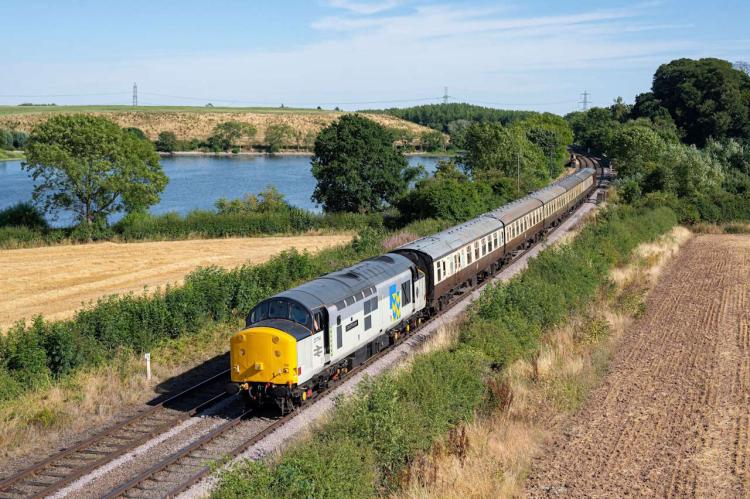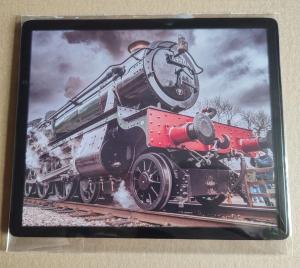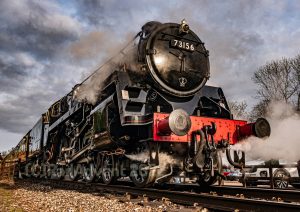The next phase of the Great Central Railway‘s long-term plan to reunify its northern and southern sections of the line has taken a major step forward with the submission of the planning application to Charnwood Borough Council.
Both halves of the Great Central Railway will become a single 18-mile heritage railway running from south of Nottingham to the north of Leicester, if the planning application is approved.
It will also see the line connected for the first time since BR closed the line in 1969, and proceeded to demolish 500-metres of the railway embankment between the two sides in the 1970s in an attempt to stop the line from being put back.
Today, the restored Great Central Railway attracts thousands of visitors each year, and is one of the major tourist attractions in Leicestershire, with its own fleet of unique locomotives and authentic rolling stock, running on the only heritage double track mainline in the country.

The plan is to build a bridge between the two sides rather than rebuilding the embankment. With the work to take place in the Loughborough area, it will not only bring economical benefit to the town, it will also secure existing jobs in the local service sector.
So far, three stages have been passed and millions of pounds raised to get the unification project this far, though to continue, the next stage is planning permission to build upon the work already achieved.
The planning application is available to view at Charnwood Borough Council’s planning explorer using this link Online Standard Results (charnwood.gov.uk), the public can also leave comments regarding the application.

With proposed plans being unveiled in April 2024, an extra £50,000 has been raised by the Great Central Railway thanks to volunteers, staff and supporters, which has helped the project on the next stage of its journey to completion. The time has now come to start turning these plans into engineering designs, drawings and specifications, with the cost of this stage expected to cost £500,000.
“As always, we are hugely grateful and humbled by the generous donations we receive from around the world to advance the project. This next stage is crucial, so we’re now asking people to contact Charnwood Borough Council and support the planning application.”
“Formally applying for planning consent is a huge milestone for this exciting project. It has required a lot of hard work and investment from our supporters and stakeholders. We’d like to thank everyone who has got behind Reunification and in particular our design consultants and advisers who have helped and guided us through this vital stage.”
General Manager of the Great Central Railway Malcolm Holmes

Fundraising for the next phase has already begun, donations can be made at gcrailway.co.uk/unify
Popular Great Central Railway Gifts From RailAdvent
-
 2025 Steam Train Calendar by RailAdvent£9.99Rated 4.70 out of 5 based on 20 customer ratings
2025 Steam Train Calendar by RailAdvent£9.99Rated 4.70 out of 5 based on 20 customer ratings -
 Great Central Railway – Winter Steam Gala 2022 – 3 Disc Set£19.99 – £27.99Rated 5.00 out of 5 based on 5 customer ratings
Great Central Railway – Winter Steam Gala 2022 – 3 Disc Set£19.99 – £27.99Rated 5.00 out of 5 based on 5 customer ratings -
 Steam locomotive mouse mat – 6990 Witherslack Hall departs Rothley, Great Central Railway£6.99
Steam locomotive mouse mat – 6990 Witherslack Hall departs Rothley, Great Central Railway£6.99 -
 73156 stands at Rothley, Great Central Railway£3.49 – £29.99
73156 stands at Rothley, Great Central Railway£3.49 – £29.99





Responses
Part of the Former Great Central Main Line between Calvert and South of Brackley is indeed being used for HS2. It’s a pity somebody didn’t have the foresight to continue to a point South of Leicester which with the construction of a new line into Birmingham from there would have saved a considerable amount of Money. It has never been the intention by anybody to run high speed services from London to Manchester via Sheffield.
The Great Central line was destroyed after closing. I saw it with my own eyes. Signal boxes set on fire, viaducts blown up, stations knocked down, some when the line was still running.There is no doubt in my mind, somebody did not want that line to be reopened.
The embankment was removed to provide spoil for the newly-created chord from the GCR onto the MML. I was a volunteer at that time. I watched it happen.
Those who are now loudly demanding the re-nationalisation of the railways forget the practices of the nationalised British Rail and its determination to shut railways down and, like this example, prevent anyone re-opening them.
Another example was the Settle-Carlisle line where British Rail steadily removed services from it, running the remaining ones at inconvenient times and then claimed the line should be shut “because no-one was using it”. Luckily (and due to then transport minister Portillo who is a bit of a rail buff) this line survived and anyone looking at the crowded trains that now run on it wouldn’t believe that British rail tried their hardest to shut it.
Our local train station closed Tibshelf Town Derbyshire in the 60s and we had to move the 5 of us with my husband’s job he was a Special Class Relief Signalman on the Central line the sacrifices we made was awful as the 3 children kept having to change schools and we moved to keep us together. We had 2 more children and then we settled in Essex.
I wish them well, this is fantastic news. The more I read about decisions made during the BR days, the more I realise that governments should not be allowed anywhere near railways. The demolition of the banking was another way of killing off railways. They were pushed mostly by the road lobby and determined to consign railways to history. My Local line was one of many that lost its Sunday services, in an attempt to close the line. It survived, and 50 years later the service was successfully restored.
In an era when close lines are being reopened, we should reflect that if the GCR had remained, there would have been no case for HS2 or its subsequent cancellation.
I very much doubt that the embankment was removed to sabotage an unlikely reinstatement. Much more likely was that it was removed to avoid maintenance costs or create space for something else – and aren’t there bridges involved?
Further the idea that the GCR would be an adequate alternative to HS2 doesn’t work – how could you run a high speed service from London to Manchester if you need to go via Sheffield?